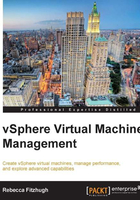
Uses of virtual machines
In any infrastructure, there are many business processes that have applications supporting them. These applications typically have certain requirements, such as security or performance requirements, which may limit the application to being the only thing installed on a given machine. Without virtualization, there is typically a 1:1:1 ratio for server hardware to an operating system to a single application. This type of architecture is not flexible and is inefficient due to many applications using only a small percentage of the physical resources dedicated to it, effectively leaving the physical servers vastly underutilized. As hardware continues to get better and better, the gap between the abundant resources and the often small application requirements widens. Also, consider the overhead needed to support the entire infrastructure, such as power, cooling, cabling, manpower, and provisioning time. A large server sprawl will cost more money for space and power to keep these systems housed and cooled.
Virtual infrastructures are able to do more with less—fewer physical servers are needed due to higher consolidation ratios. Virtualization provides a safe way of putting more than one operating system (or virtual machine) on a single piece of server hardware by isolating each VM running on the ESXi host from any other. Migrating physical servers to virtual machines and consolidating onto far fewer physical servers means lowering monthly power and cooling costs in the datacenter. Fewer physical servers can help reduce the datacenter footprint; fewer servers means less networking equipment, fewer server racks, and eventually less datacenter floor space required. Virtualization changes the way a server is provisioned. Initially it took hours to build a cable and install the OS; now it takes only seconds to deploy a new virtual machine using templates and cloning.
VMware offers a number of advanced features that aren't found in a strictly physical infrastructure. These features, such as High Availability, Fault Tolerance, and Distributed Resource Scheduler, help with increased uptime and overall availability. These technologies keep the VMs running or give the ability to quickly recover from unplanned outages. The ability to quickly and easily relocate a VM from one ESXi host to another is one of the greatest benefits of using vSphere virtual machines.
In the end, virtualizing the infrastructure and using virtual machines will help save time, space, and money. However, keep in mind that there are some upfront costs to be aware of. Server hardware may need to be upgraded or new hardware purchased to ensure compliance with the VMware Hardware Compatibility List (HCL). Another cost that should be taken into account is the licensing costs for VMware and the guest operating system; each tier of licensing allows for more features but drives up the price to license all of the server hardware.